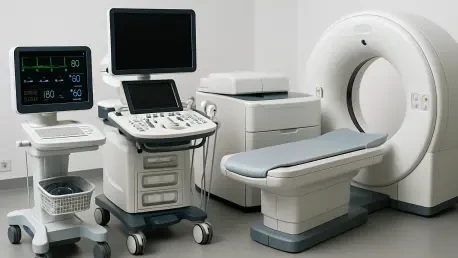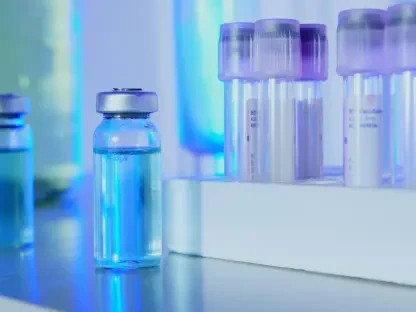The healthcare industry is currently gripped by speculation over Siemens Healthineers’ potential decision to sell its diagnostics division for a staggering amount exceeding $7 billion, a move that could send shockwaves through the in vitro diagnostics (IVD) market. This possible transaction, involving discussions with heavyweight private equity firms such as Blackstone, CVC Capital Partners, and KKR, has placed Siemens—a major supplier of critical testing equipment and reagents to clinical laboratories worldwide—under intense scrutiny. The implications of such a deal are vast, touching on everything from innovation in medical testing to the stability of pricing structures for labs. Beyond the immediate financial aspects, this sale prompts deeper questions about how patient care might be affected by shifts in ownership and strategic priorities. This article aims to unpack the layers of this developing story, examining what it means for healthcare providers, investors, and the broader medtech landscape as Siemens contemplates a significant pivot.
A Strategic Overhaul at Siemens Healthineers
Siemens Healthineers, headquartered in Erlangen, Germany, appears to be at a critical juncture as it evaluates the future of its diagnostics unit, which has reportedly been a drag on overall growth and profitability. For over two years, the company has been conducting a thorough portfolio review, seeking to sharpen its focus on high-growth areas like medical imaging and cancer-care technologies through its Varian unit. Divesting the diagnostics arm could provide a much-needed infusion of capital, enabling Siemens to redirect resources toward sectors with stronger margins and innovation potential. Such a move mirrors a broader trend in the medical technology industry, where firms are increasingly shedding underperforming divisions to adapt to escalating global healthcare demands. If successful, this strategic shift could position Siemens as a more agile and specialized player, potentially setting a new standard for how medtech giants prioritize their investments.
This strategic realignment, however, is not without its complexities, as the diagnostics business remains a cornerstone of Siemens Healthineers’ identity in the IVD sector, where it ranks among the top global players. The decision to sell could signal a departure from a long-standing commitment to comprehensive healthcare solutions, raising questions about the company’s long-term vision. While focusing on imaging and radiotherapy might yield quicker financial returns, it also risks ceding ground in a diagnostics market that, despite current challenges, holds significant potential for growth amid rising demand for personalized medicine and rapid testing. Industry observers note that streamlining operations could enhance shareholder value, but it may also require Siemens to navigate a delicate balance between short-term gains and maintaining influence in a vital healthcare segment. The outcome of these discussions will likely serve as a litmus test for similar strategic pivots across the sector.
Private Equity’s Stake in Healthcare Transformation
The intense interest from private equity giants like Blackstone, CVC Capital Partners, and KKR underscores a growing appetite for healthcare investments, particularly in diagnostics, which is viewed as a resilient and promising field. With a valuation surpassing $7 billion, Siemens’ diagnostics unit is seen as a prime asset, despite its struggles with profitability. Private equity firms are drawn by the sector’s stability and the opportunity to drive operational improvements, potentially turning around underperforming divisions through targeted investments and restructuring. This trend of financial investors entering healthcare could accelerate if the Siemens deal materializes, possibly triggering a wave of comparable transactions that reshape corporate strategies across the industry. The involvement of such major players highlights the high stakes and the transformative potential of this sale.
Beyond the immediate financial allure, private equity’s role in healthcare raises broader considerations about the direction of the diagnostics market. These firms often prioritize efficiency and cost-cutting, which could lead to significant changes in how Siemens’ diagnostics operations are managed post-sale. While fresh capital might spur innovation or expand market reach, there’s also the risk of reduced focus on long-term research and development in favor of short-term profit gains. For stakeholders, this dynamic introduces a layer of uncertainty about whether patient-centric priorities will remain at the forefront under new ownership. As private equity continues to eye healthcare assets, the Siemens case could become a benchmark for how such investments balance financial objectives with the critical need for reliable medical technologies, influencing future deals in this space.
Ripple Effects on Clinical Laboratories and Patient Outcomes
Clinical laboratories around the globe are bracing for potential disruptions as Siemens Healthineers contemplates this monumental sale, given the company’s pivotal role in supplying systems and reagents for processing millions of patient samples annually. A change in ownership could alter pricing models, product availability, and even the quality of customer support, all of which are crucial for seamless lab operations. Industry experts are already advising lab leaders to take proactive steps, such as reinforcing supply chain resilience and maintaining open communication with vendors to mitigate any fallout. With the IVD market experiencing rapid consolidation—evidenced by recent partnerships like BD’s integration with Waters—this potential transaction could further complicate an already shifting landscape, directly impacting the efficiency of diagnostic services.
The implications extend beyond operational logistics to the heart of patient care, where diagnostics play an indispensable role in detecting diseases and guiding treatment decisions. Any instability in the supply or innovation of Siemens’ testing solutions could delay critical diagnoses, affecting patient outcomes on a wide scale. Laboratories, particularly those heavily reliant on Siemens’ technology, may face tough choices about diversifying suppliers or investing in contingency plans to ensure continuity. Meanwhile, the uncertainty surrounding the sale adds pressure on healthcare providers to adapt quickly to potential changes, emphasizing the interconnectedness of corporate decisions and frontline medical services. As this situation unfolds, the priority for labs must be safeguarding the reliability of diagnostic processes amid an evolving industry dynamic.
Market Dynamics and Investor Confidence
Investor sentiment surrounding Siemens Healthineers has shown notable fluctuations as news of the potential $7 billion diagnostics sale emerged, with the company’s stock experiencing a significant intraday rise of up to 3.6% following initial reports. Despite a year-to-date decline in share value, this uptick suggests market optimism about the prospect of a leaner, more focused Siemens, unburdened by the lower margins of its diagnostics unit. Analysts, including those at Bank of America, maintain a positive outlook, projecting robust growth in key regions like the US and Europe by 2026. Upcoming events such as the Capital Markets Day in November are anticipated to provide further clarity on the company’s strategic direction, fueling speculation about how this deal could unlock long-term value and enhance profitability.
Looking deeper into market reactions, the potential divestiture is seen as a catalyst for simplifying Siemens Healthineers’ business structure, which could attract additional investment and drive share price momentum. The parent company, Siemens AG, which holds a majority stake, has also recently adjusted its holdings, signaling a broader restructuring effort that aligns with investor expectations for streamlined operations. For shareholders, the promise of redirected resources toward high-growth areas like imaging offers hope for sustained returns, though the speculative nature of the sale introduces an element of risk. As the financial community awaits concrete developments, the consensus leans toward cautious optimism, with many viewing this as a pivotal moment for Siemens to redefine its market positioning and capitalize on emerging healthcare trends.
Navigating the Future of Diagnostics in Healthcare
Reflecting on the unfolding events, the prospective $7 billion sale of Siemens Healthineers’ diagnostics division to private equity firms stands as a defining moment for the IVD industry, capturing the attention of clinical labs and investors alike with its far-reaching implications. The discussions, though preliminary and without guaranteed outcomes, highlight a critical intersection of corporate strategy and healthcare delivery. Lab leaders face the challenge of preparing for potential shifts in supply dynamics, while financial markets respond with a mix of anticipation and uncertainty about Siemens’ streamlined future. As strategic updates are awaited in the months that follow, this scenario underscores the profound impact of such transactions on everyday medical operations. Moving forward, stakeholders are encouraged to prioritize adaptability—whether through diversified vendor relationships for labs or vigilant portfolio analysis for investors—to navigate the evolving landscape and ensure that patient care remains uncompromised amidst industry transformations.









